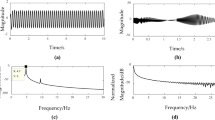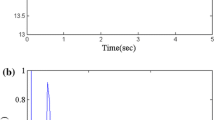Abstract
In this paper, in order to improve the fault detection of the broken rotor bars, models of healthy machine, one and two broken rotor bar machines taking a count the first space harmonics were simulated. Motor current signature analysis method is the technique for extracting information of the stator current in the band frequency of 0–700 Hz. The results show that the study of the sidebands presented around the supply frequency, the principal components and the additional components of the space harmonics enables us to carry out a more precise state of the rotor defect. This method gives more information on the state of the machine to carry out a more precise diagnosis study. The experimental results prove the efficiency of the proposed method.























Similar content being viewed by others
References
Toliyat HA, Lipo TA (1995) Transient analysis of cage induction machines under stator, rotor bar and end ring faults. IEEE Trans Energy Convers 10(2):241–247
Liu Z, Yin X, Zhang Z, Chen D (2004) Online rotor mixed fault diagnosis way based on spectrum analysis of instantaneous power in squirrel cage induction motors. IEEE Trans Energy Convers 19(3):485–490
Karimi S, Poure P, Saadate S (2009) Fast power switch failure detection for fault tolerant voltage source inverters using FPGA. IET Power Electron 2(4):346–354
Pineda-Sanchez M, Riera-Guasp M, Antonino-Daviu JA, Roger-Folch J, Perez-Cruz J, Puche-Panadero R (2010) Diagnosis of induction motor faults in the fractional Fourier domain. IEEE Trans Instrum Meas 59(8):2065–2075
Espinoza-Trejo DR, Campos-Delgado DU, Barcenas E, Martınez-Lopez FJ (2012) Robust fault diagnosis scheme for open-circuit faults in voltage source inverters feeding induction motors by using non-linear proportional-integral observers. IET Power Electron 5(7):1204–1216
Gritli Y, Zarri L, Rossi C, Filippetti F, Capolino GA, Casadei D (2013) Advanced diagnosis of electrical faults in wound-rotor induction machines. IEEE Trans Ind Electron 60(9):4012–4024
Vedreño-Santos F, Riera-Guasp M, Henao H, Pineda-Sánchez M, Puche-Panadero R (2014) Diagnosis of rotor and stator asymmetries in wound-rotor induction machines under nonstationary operation through the instantaneous frequency. IEEE Trans Ind Electron 61(9):4947–4959
Seshadrinath J, Singh B, Panigrahi BK (2014) Vibration analysis based interturn fault diagnosis in induction machines. IEEE Trans Ind Inf 10(1):340–350
Sapena-Baño A, Pineda-Sanchez M, Puche-Panadero R, Perez-Cruz J, Roger-Folch J, Riera-Guasp M, Martinez-Roman J (2015) Harmonic order tracking analysis: a novel method for fault diagnosis in induction machines. IEEE Trans Energy Convers 30(3):833–841
Trachi Y, Elbouchikhi E, Choqueuse V, Benbouzid MEH, Wang T (2017) A novel induction machine fault detector based on hypothesis testing. IEEE Trans Ind Appl 53(3):3039–3048
Burriel-Valencia J, Puche-Panadero R, Martinez-Roman J, Sapena-Bano A, Pineda-Sanchez M (2017) Short-frequency fourier transform for fault diagnosis of induction machines working in transient regime. IEEE Trans Instrum Meas 66(3):432–440
Sapena-Bano A, Burriel-Valencia J, Pineda-Sanchez M, Puche-Panadero R, Riera-Guasp M (2017) The harmonic order tracking analysis method for the fault diagnosis in induction motors under time-varying conditions. IEEE Trans Energy Convers 32(1):244–256
Aimer AF, Boudinar AH, Benouzza N, Bendiabdellah A (2017) Induction motor bearing faults diagnosis using Root-AR approach: simulation and experimental validation. Electrical Engineering, pp. 1–10
Benbouzid MEH, Kliman GB (2003) What stator current processing-based techniques to use for induction motor rotor faults diagnosis. IEEE Trans Energy Convers 18(2):238–244
Bruzzese C, Honorati O, Santini E (2005) Rotor bars breakage in railway traction squirrel cage induction motors and diagnosis by MCSA technique. Part I: accurate fault simulations and spectral analyses. IEEE SDEMPED 2005, 7-9 September 2005, Vienna, Austria
Puche-Panadero R, Pineda-Sanchez M, Riera-Guasp M, Roger-Folch J, Hurtado-Perez E, Perez-Cruz J (2009) Improved resolution of the MCSA method via hilbert transform, enabling the diagnosis of rotor asymmetries at very low slip. IEEE Trans Energy Convers 24(1):52–59
Riera-Guasp M, Cabanas MF, Antonino-Daviu JA, Pineda-Sanchez M, Garcia CHR (2010) Influence of nonconsecutive bar breakages in motor current signature analysis for the diagnosis of rotor faults in induction motors. IEEE Trans Energy Convers 25(1):80–89
Hamdani S, Bouzida A, Touhami O, Ibtiouen R (208) Diagnosis of rotor fault in induction motor using the MUSIC analysis of the terminal voltage after switch-off. In Proceedings of International Conference Electrical and Machine, pp. 1–5
Elbouchikhi E, Choqueuse V, Benbouzid M (2016) Induction machine bearing faults detection based on a multi-dimensional MUSIC algorithm and maximum likelihood estimation. ISA Trans 63:413–424
Bouzida A, Touhami O, Ibtiouen R, Belouchrani A, Fadel M, Rezzoug A (2011) Fault diagnosis in industrial induction machines through discrete wavelet transform. IEEE Trans Ind Electron 58(9):4385–4395
Keskes H, Braham A, Lachiri Z (2013) Broken rotor bar diagnosis in induction machines through stationary wavelet packet transform and multiclass wavelet SVM. Electr Power Syst Res 97:151–157
Seshadrinath J, Singh B, Panigrahi BK (2014) Incipient interturn fault diagnosis in induction machines using an analytic wavelet-based optimized bayesian inference. IEEE Trans Neural Netw Learn Syst 25(5):990–1001
Gyftakis KN, Antonino-Daviu JA, Garcia-Hernandez R, McCulloch MD, Howey DA, Antonio J (2016) Comparative experimental investigation of broken bar fault detectability in induction motors. IEEE Trans Ind Appl 52(2):1452–1459
Jerkan DG, Reljić DD, Marčetić DP (2017) Broken rotor bar fault detection of IM based on the counter-current braking method. IEEE Trans Energy Convers 32(4):1356–1366
Abd-el-Malek M, Abdelsalam AK, Hassan OE (2017) Induction motor broken rotor bar fault location detection through envelope analysis of start-up current using Hilbert transform. Mech Syst Signal Process 93:332–350
Cruz SM, Marques Cardoso AJ (2004) Diagnosis of stator inter-turn short circuits in DTC induction motor drives. IEEE Trans Ind Appl 40(5):1349–1360
Masrur MA, Chen Z, Murphey Y (2010) Intelligent diagnosis of open and short circuit faults in electric drive inverters for real-time applications. IET Power Electron 3(2):279–291
Immovilli F, Bellini A, Rubini R, Tassoni C (2010) Diagnosis of bearing faults in induction machines by vibration or current signals: a critical comparison. IEEE Trans Ind Appl 46(4):1350–1359
Drif M, Cardoso AJM (2008) Airgap-eccentricity fault diagnosis, in three-phase induction motors, by the complex apparent power signature analyses. IEEE Trans Ind Electron 55(3):1404–1410
Faiz J, Ebrahimi BM, Akin B, Toliyat HA (2010) Dynamic analysis of mixed eccentricity signatures at various operating points and scrutiny of related indices for induction motors. IET Electr Power Appl 4(1):1–16
Bruzzese C, Joksimovic G (2011) Harmonic signatures of static eccentricities in the stator voltages and in the rotor current of no-load salient-pole synchronous generators. IEEE Trans Ind Electron 58(5):1606–1624
Faiz J, Moosavi SMM (2016) Eccentricity fault detection: from induction machines to DFIG—a review. Renew Sustain Energy Rev 55:169–179
Garcia-Perez A, de Jesus Romero-Troncoso R, Cabal-Yepez E, Osornio-Rios RA (2011) The application of high-resolution spectral analysis for identifying multiple combined faults in induction motors. IEEE Trans Ind Electron 58(5):2002–2010
Martínez-Morales JD, Palacios-Hernández ER, Campos-Delgado DU (2016) Multiple-fault diagnosis in induction motors through support vector machine classification at variable operating conditions. Electr Eng 100:1–15
Boccaletti C, Bruzzese C, Honorati O, Santini E (2005) Rotor bars breakage in railway traction squirrel cage induction motors and diagnosis by MCSA technique, Part II: theoretical arrangements for fault-related current sidebands. In: IEEE SDEMPED 2005, 7-9 September 2005, Vienna, Austria
Shoen RR, Habetler TG (1995) Effects of time-varying loads on rotor fault detection in induction machines. IEEE Trans Ind Appl 31:900–906
Didier G, Ternisien E, Caspary O, Razik H (2006) Fault detection of broken rotor bars in induction motor using a global fault index. IEEE Trans Ind Appl 42(1):79–88
Didier G, Ternisien E, Razik H (2005) Detection of incipient rotor cage fault and mechanical abnormalities in induction motor using global modulation index on the line current spectrum. In International symposium on diagnostics for electric machines, power electronics and drives, Vienna, Austria, 7-9 September 2005
Fudeh HR, Ong CM (1985) Modeling and analysis of induction machine containing space harmonics, Part. I, modeling and transformation. IEEE Trans Power Appar Syst 102(8):2608–2628
Fudeh HR, Ong CM (1985) Modeling and analysis of induction machine containing space harmonics, Part. III, three- phase cage rotor induction machine. IEEE Trans Power Appar Syst 102(8):2608–2628
Author information
Authors and Affiliations
Corresponding author
Appendix
Rights and permissions
About this article
Cite this article
Ouadah, M., Touhami, O. & Ibtiouen, R. Improvement of the detection of the defect squirrel cage rotor by the study of additional components of the space harmonics. Electr Eng 100, 2485–2497 (2018). https://doi.org/10.1007/s00202-018-0728-2
Received:
Accepted:
Published:
Issue Date:
DOI: https://doi.org/10.1007/s00202-018-0728-2




